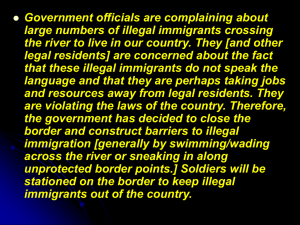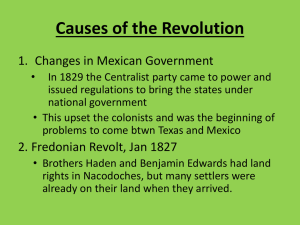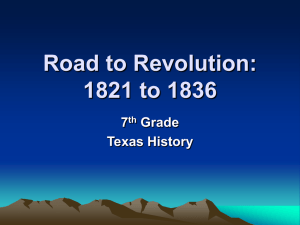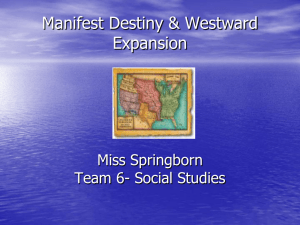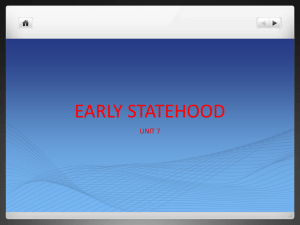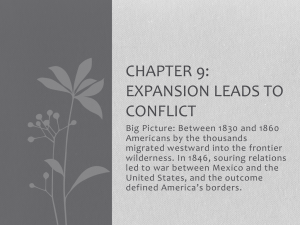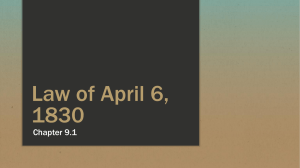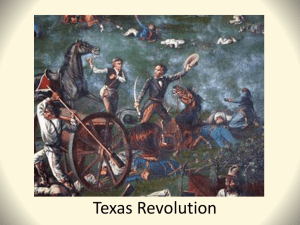Unit 5 Section 4 Notes - Rogers Independent School District
advertisement
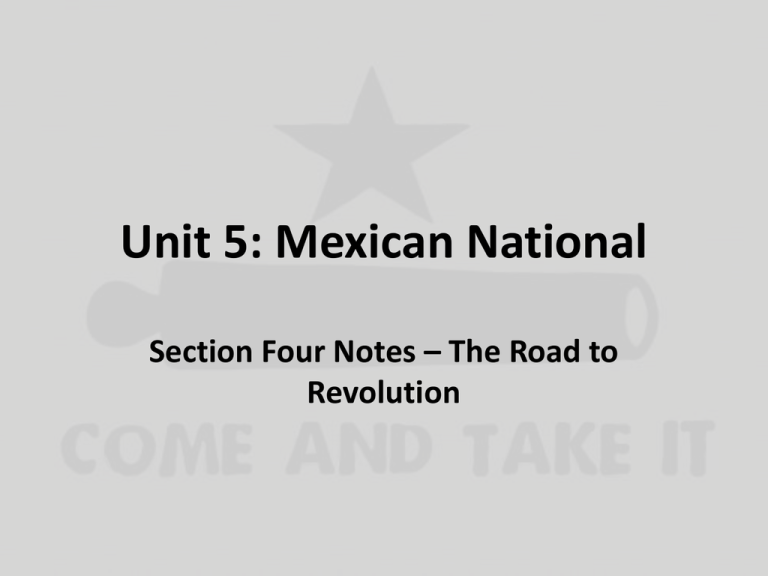
Unit 5: Mexican National Section Four Notes – The Road to Revolution Mexican Federal Constitution of 1824 Mexico gained its independence from Spain in 1821 and became a republic in 1822, but it took a little while for the government to become official and stable. In 1824, the Mexican government established a republic with the writing of the Mexican Federal Constitution. The country was then called the United Mexican States. With the Constitution of 1824… People were elected to represent citizens in the government, and the official religion of the country was Catholicism. Like the U.S. Constitution, it gave some power to the federal government and most of the power to the states. This is known as federalism. U.S. Constitution vs. Mexican Constitution of 1824 Similarities • Both created federalist governments, with most of the power going to the states. • Both created 3 branches of government. • A president would serve as the head of the government. Differences • Mexico’s law makers, not their citizens, elected the president. • There was no separation of church and state in the new Mexican government. • No freedom of religion – Roman Catholicism was the official religion of Mexico. Constitution of 1824 PROS CONS Merger of Texas and Coahuila Once the Constitution of 1824 was passed, the government created states. The provinces of Texas and Coahuila were merged to create Coahuila y Tejas. Texas was not organized as its own state because the Texas population was too small. Colonization Problems The Mexican government gave contracts to empresarios in order to colonize Texas, but this sometimes led to problems. Often, the contracts would include land that was already lived on by Mexican families, Indians, or other U.S. citizens. These kinds of disputes led to small disagreements and larger problems throughout Texas. Haden Edwards The Fredonian Rebellion began with a dispute over land. Haden Edwards was an empresario who had been given permission to settle 800 families in East Texas, but when he arrived, the land was already settled on. Many of the settlers could not prove that the land was theirs, so Edwards demanded that they pay him. When they refused, Edwards complained to the governor who sided with the settlers. The Fredonian Rebellion In October of 1826, the Mexican government cancelled Edward’s contract, and Haden’s brother, Benjamin, took action. Benjamin and a group of Texas settlers took up arms and claimed a section of East Texas as an independent nation called Fredonia. They even wrote a declaration of independence. In January of 1827, Mexican troops marched to put down the rebellion, and most of the rioters fled. Some were captured and later released after Stephen F. Austin spoke on their behalf. Results of the Fredonian Rebellion Though it was one incident, this made the Mexican government worry about other U.S. citizens in Texas. They were afraid that the U.S. would attempt to take Texas from them. The Mexican government soon began to limit the amount of trade allowed between people in Texas and the people in the U.S. They also encouraged more Europeans and Mexicans to settle in Texas so that it wouldn’t be completely made up of former U.S. citizens. Slavery and the Law of April 6, 1830 Texans did not always agree with the laws in Mexico. Many still felt like U.S. citizens and these Texans in power often created a mixture of U.S. and Mexican law in Texas. Slavery soon became an issue that was difficult to work around. Slavery Laws • In 1821, colonists were allowed to bring slaves with them into Texas. They even received more land for having them! • In 1823, the sale or purchase of slaves became illegal. The children of slaves were required to be set free at the age of 14. Mexico also offered full citizenship to free blacks, including the right to own land. • By 1827, the state of Coahuila y Tejas outlawed the introduction of additional slaves and granted freedom at birth to all children born to a slave. • In 1829, Mexico abolished slavery, but it granted an exception to Texas. Law of April 6, 1830 It was the Mexican President, Vincente Guerrero, who issued a decree outlawing slavery in Mexico in 1829. Then the Law of April 6, 1830 banned U.S. immigration to Texas and made it illegal for more slaves to be brought into Texas. It also taxed goods coming into Texas from the United States. Possible Problems with the Law of April 6, 1830 Conflict at Anahuac • The Mexican government sent troops to Anahuac to enforce the Law of April 6, 1830. • Many Texans refused to pay the tax on goods, and one disagreement led to the wounding of a soldier. Austin smoothed over the incident, but many in Texas and Mexico were still angered. Federalism vs. Centralism Mexico soon had a new president, President Anastacio Bustamante. He had taken complete control of the government by ignoring the Constitution of 1824 and creating a centralist government. Instead of power being in the hands of the state, all the power was in the hands of the president and other members of the national government. This also angered many throughout Texas. The Turtle Bayou Resolutions A group of Texans living outside of Anahuac, Texas, marched on Anahuac in order to get a friend, Patrick Jack, out of jail. (He may have refused to pay a tax.) They exchanged gunfire with the troops and captured a soldier. The Mexican government saw this as a revolt, but the group wrote a resolution claiming that they were simply defending the Constitution of 1824. They also expressed their support for General Antonio López de Santa Anna, who was trying to overthrow President Bustamante. Texans Unorganized Eventually the situation at Anahuac was resolved, but others who had just heard about Anahuac were angry and decided to attack Mexican troops. This led to the Battle of Velasco, where both Texan and Mexican soldiers were killed. Though this should have caused a backlash against the settlers, the Mexican soldiers were soon called back to Mexico. President Bustamante was fighting his own war against the Federalists, led by Santa Anna. Conventions of 1832 and 1833 Hoping that Santa Anna would take over the government and restore the Constitution of 1824, the political leaders in Texas decided to hold a convention to discuss possible reforms, or changes in policy. Each district in Texas was asked to send delegates, or representatives. Stephen F. Austin was then sent to Mexico to present their proposals or requests. Four Proposals of the Conventions of 1832 and 1833 1. They asked the Mexican government to allow legal immigration from the United States. 2. The delegates requested that Texas become a separate Mexican state instead of being joined with Coahuila. 3. The Texans asked that customs duties (or taxes on goods from the United States) be removed for three years. 4. The delegates asked for land for public schools. Austin’s Arrest When Austin reached Mexico City three months later, the new government in Mexico was still unstable and thousands of people were dying of cholera in the city. He was unable to meet with Santa Anna, so he went ahead and wrote to the delegates, telling them to set up a state government, though he had not received permission. After meeting with Santa Anna, the Mexican officials found out about his letter and they arrested him. He was put in prison for over a year. Battle of Gonzales In 1834, Santa Anna went back on his promises and created a centralist government, claiming that Mexico was not ready to become a republic. Some in Texas became angry. Mexican soldiers were sent back to Texas to control conflicts. When a Mexican officer in San Antonio ordered U.S. settlers at Gonzales to hand over a brass cannon, they refused. They made a flag, challenging the soldiers to COME AND TAKE IT! War Had Begun On October 2, the settlers attacked. The battle of Gonzales was brief, leaving at least one Mexican soldier dead, but no Texas settlers were killed. The Mexican army withdrew, starting the rebellion. The Texas Revolution had begun!
